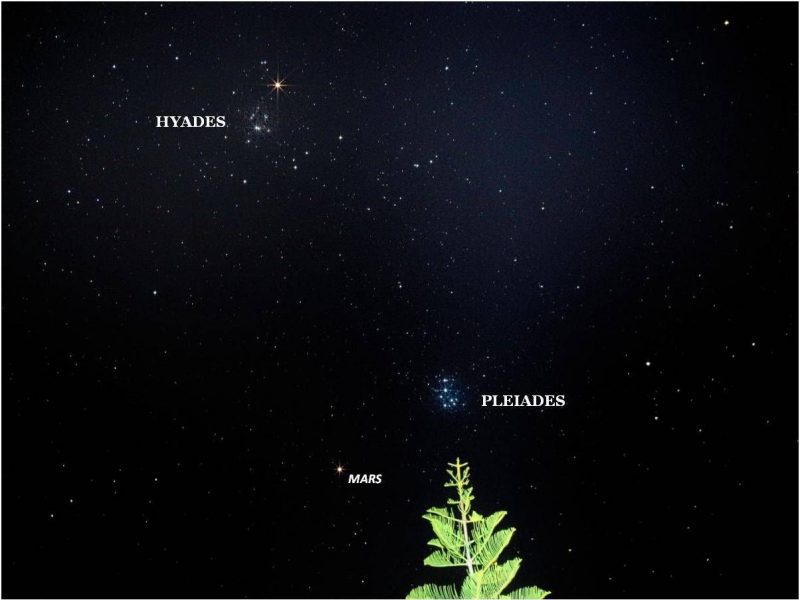
These next three evenings – February 17, 18 and 19, 2021 – watch the moon change position day by day. The waxing crescent moon pairs up with the faint planet Uranus on February 17, flits by the red planet Mars on February 18, and then joins up with the red star Aldebaran on February 19. Although Mars and Aldebaran are similar in brightness and color, with both of them shining as brilliantly as a 1st-magnitude star, don’t expect to see faint Uranus without optical aid. Mars and Aldebaran outshine distant and faint Uranus by a hundredfold.
The feature chart at top is designed for North America. Even so, people around the world can still use this chart to approximate the moon’s position relative to Mars and Aldebaran. At nightfall on the same date in Europe and Africa, the moon is offset by roughly 1/4 the way westward (toward the previous date); from Asia, the offset is about half the way westward (toward the previous date). From anywhere on Earth, the moon moves about 13 degrees eastward per day in front of the constellations of the zodiac.
Find out which constellation now backdrops the moon via Heavens-Above.
Another way of putting it is that the moon travels about half a degree eastward per hour in front of the background stars of the zodiac. For a convenient reference, the moon’s angular diameter spans about half a degree of sky.
The 2021 lunar calendars are here. A few left. Order yours before they’re gone!

Sizes of planets are to scale but the distances apart are not. On February 17, 2021, Mars, the 4th planet from the sun, resides 1.57 astronomical units (AU) from the sun and 1.36 AU from Earth. Uranus, the 7th planet from the sun, lies 19.77 AU from the sun and 20.11 AU from Earth. Information via Heavens-Above.
All throughout the year 2021, the moon – in its monthly sojourns through the constellation Taurus the Bull – always passes to the north of Aldebaran and to the south of the Pleiades star cluster. Month by month, however, the moon strolls farther north of Aldebaran and closer to the Pleiades. By the year 2023, the moon will have moved far enough northward in Taurus to occult (pass in front of) Alcyone, the Pleiades’ brightest star. This occultation series of the star Alcyone will start on September 5, 2023, and end on July 7, 2029, for a total of 79 occultations.
Right now, Mars shines in front of the constellation Aries the Ram. One week later, on February 24, 2021, the red planet will have moved in front of the constellation Taurus the Bull. Mars will remain in front of Taurus for about two months, until it passes into the constellation Gemini the Twins on April 24, 2021.
Find out which constellation is the backdrop for Mars or any planet via Heavens-Above.
Keep your eye on Mars while it’s still relatively bright in your sky. Although Mars is slowly dimming, it will still be fairly easy to see for the next few months. Watch for Mars to swing 2.6 degrees south of the Pleiades on March 3, 2021, and 7 degrees north of Aldebaran on March 20, 2021.

View at EarthSky Community Photos. | Mars swings by the Pleiades every other year. This photo of Mars and the Pleiades is from March 25, 2019. Dr Ski caught the pairing from the Philippines. The Pleiades are shaped like a tiny dipper. Notice that Mars and Aldebaran (star at the upper left) are both ruddy in color. Thanks, Dr Ski!
Bottom line: These next several days – February 17, 18 and 19, 2021 – use the waxing crescent moon to find the red planet Mars, and then watch for Mars to parade through the constellation Taurus the Bull from February 24 to April 24, 2021.
from EarthSky https://ift.tt/3quvNu2

These next three evenings – February 17, 18 and 19, 2021 – watch the moon change position day by day. The waxing crescent moon pairs up with the faint planet Uranus on February 17, flits by the red planet Mars on February 18, and then joins up with the red star Aldebaran on February 19. Although Mars and Aldebaran are similar in brightness and color, with both of them shining as brilliantly as a 1st-magnitude star, don’t expect to see faint Uranus without optical aid. Mars and Aldebaran outshine distant and faint Uranus by a hundredfold.
The feature chart at top is designed for North America. Even so, people around the world can still use this chart to approximate the moon’s position relative to Mars and Aldebaran. At nightfall on the same date in Europe and Africa, the moon is offset by roughly 1/4 the way westward (toward the previous date); from Asia, the offset is about half the way westward (toward the previous date). From anywhere on Earth, the moon moves about 13 degrees eastward per day in front of the constellations of the zodiac.
Find out which constellation now backdrops the moon via Heavens-Above.
Another way of putting it is that the moon travels about half a degree eastward per hour in front of the background stars of the zodiac. For a convenient reference, the moon’s angular diameter spans about half a degree of sky.
The 2021 lunar calendars are here. A few left. Order yours before they’re gone!

Sizes of planets are to scale but the distances apart are not. On February 17, 2021, Mars, the 4th planet from the sun, resides 1.57 astronomical units (AU) from the sun and 1.36 AU from Earth. Uranus, the 7th planet from the sun, lies 19.77 AU from the sun and 20.11 AU from Earth. Information via Heavens-Above.
All throughout the year 2021, the moon – in its monthly sojourns through the constellation Taurus the Bull – always passes to the north of Aldebaran and to the south of the Pleiades star cluster. Month by month, however, the moon strolls farther north of Aldebaran and closer to the Pleiades. By the year 2023, the moon will have moved far enough northward in Taurus to occult (pass in front of) Alcyone, the Pleiades’ brightest star. This occultation series of the star Alcyone will start on September 5, 2023, and end on July 7, 2029, for a total of 79 occultations.
Right now, Mars shines in front of the constellation Aries the Ram. One week later, on February 24, 2021, the red planet will have moved in front of the constellation Taurus the Bull. Mars will remain in front of Taurus for about two months, until it passes into the constellation Gemini the Twins on April 24, 2021.
Find out which constellation is the backdrop for Mars or any planet via Heavens-Above.
Keep your eye on Mars while it’s still relatively bright in your sky. Although Mars is slowly dimming, it will still be fairly easy to see for the next few months. Watch for Mars to swing 2.6 degrees south of the Pleiades on March 3, 2021, and 7 degrees north of Aldebaran on March 20, 2021.

View at EarthSky Community Photos. | Mars swings by the Pleiades every other year. This photo of Mars and the Pleiades is from March 25, 2019. Dr Ski caught the pairing from the Philippines. The Pleiades are shaped like a tiny dipper. Notice that Mars and Aldebaran (star at the upper left) are both ruddy in color. Thanks, Dr Ski!
Bottom line: These next several days – February 17, 18 and 19, 2021 – use the waxing crescent moon to find the red planet Mars, and then watch for Mars to parade through the constellation Taurus the Bull from February 24 to April 24, 2021.
from EarthSky https://ift.tt/3quvNu2

Aucun commentaire:
Enregistrer un commentaire